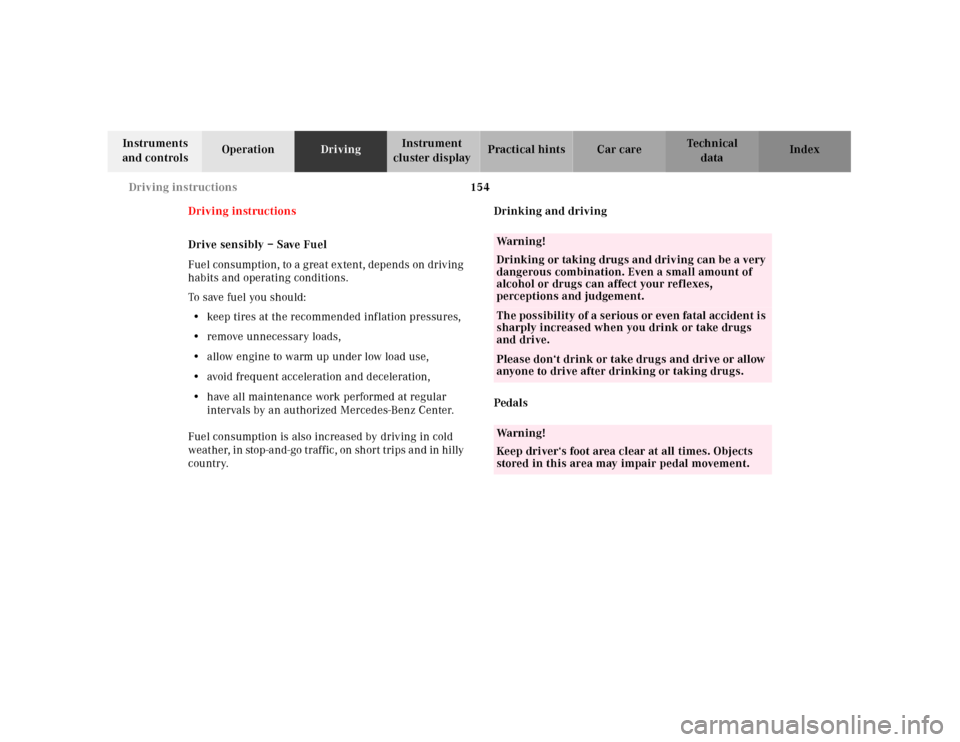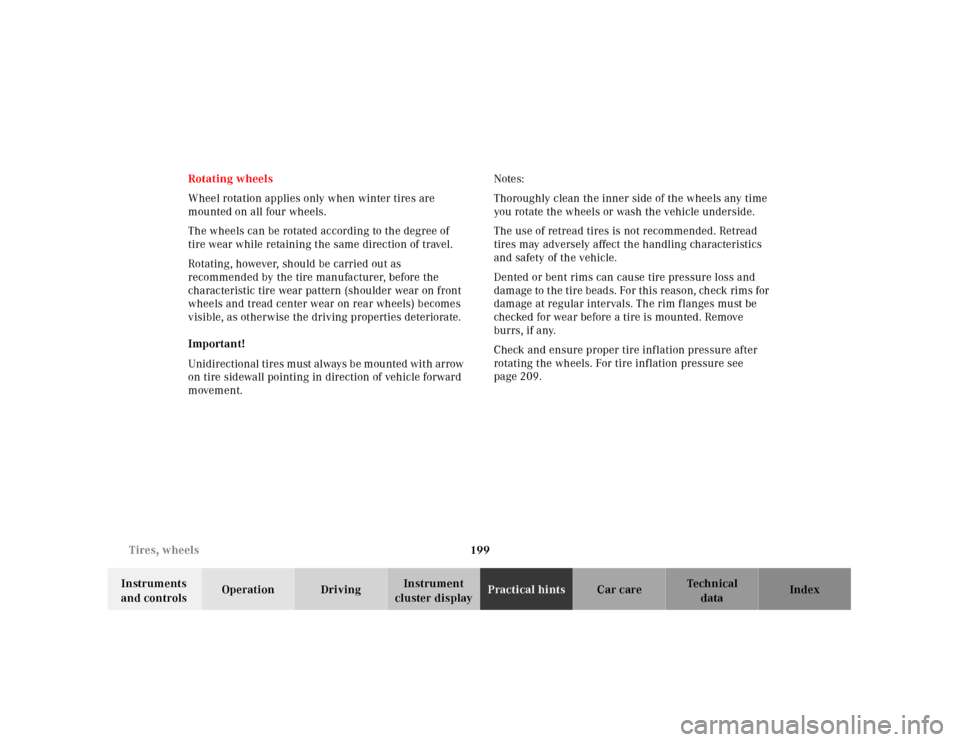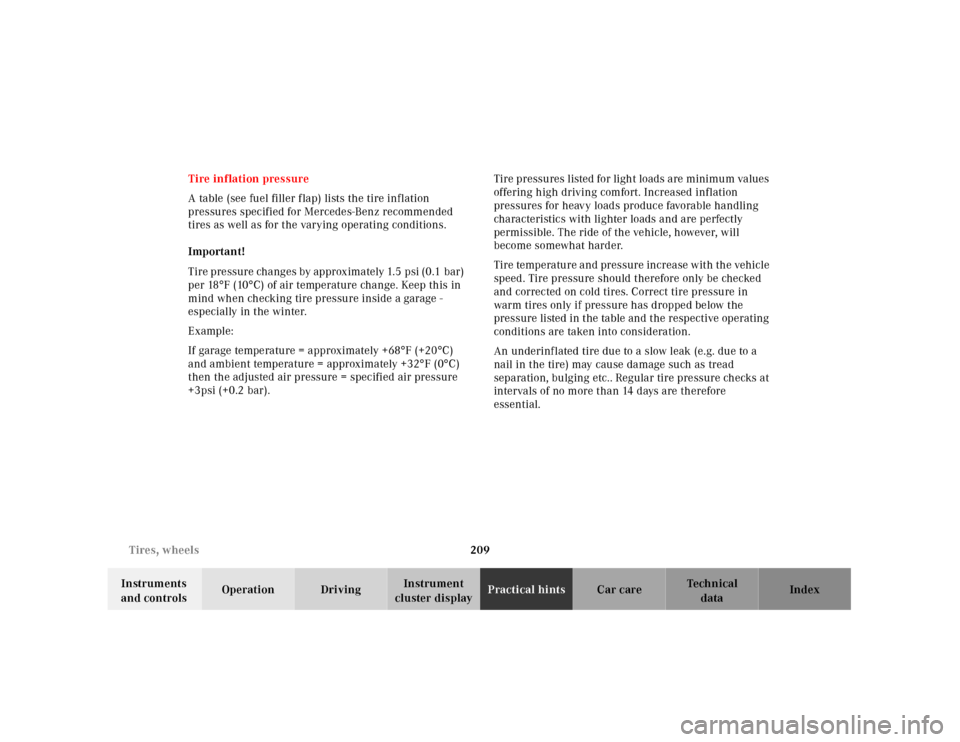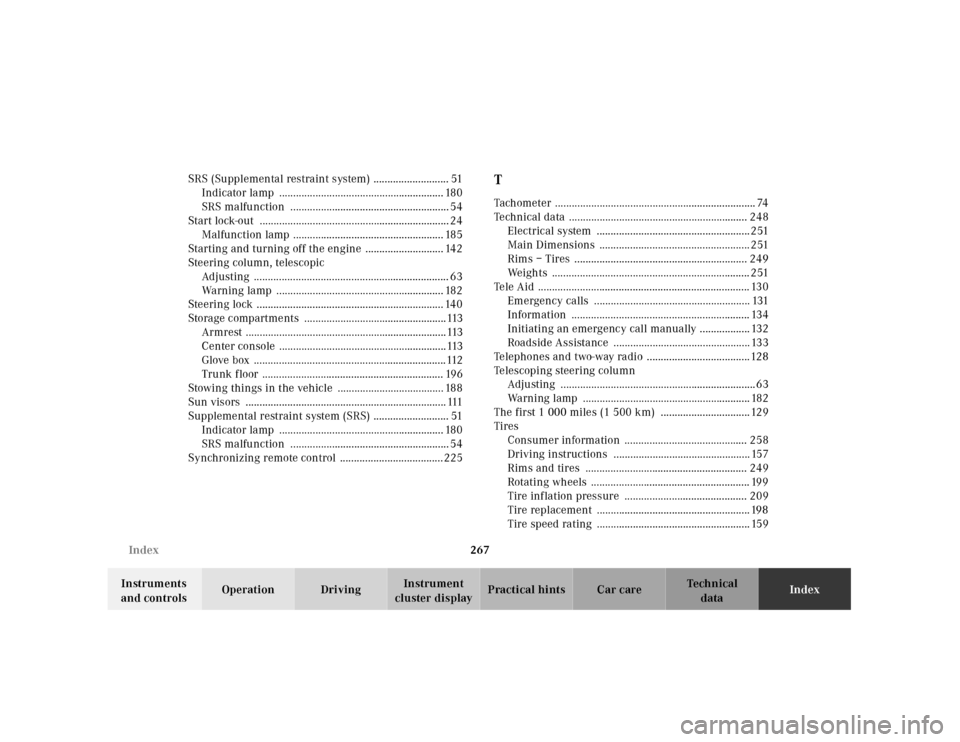2000 MERCEDES-BENZ SLK230 inflation pressure
[x] Cancel search: inflation pressurePage 6 of 273

3 Contents
Instrument cluster displayMalfunction and indicator
lamps in the instrument
cluster ......................................... 178
On-board diagnostic system ..... 178
Check engine malfunction
indicator lamp ............................. 178
Brake warning lamp .................. 179
Brake pad wear
indicator lamp ............................. 180
Seat belt nonusage
warning lamp .............................. 180
Supplemental restraint
system (SRS)
indicator lamp ............................. 180
Fuel reserve and fuel cap
placement warning .................... 181
Electronic stability
program (ESP) —
warning lamp .............................. 181
BAS / ESP malfunction
indicator lamp ............................. 181
ABS malfunction
indicator lamp ............................. 182Telescoping steering
column warning lamp ................182
Low engine coolant level
warning lamp ..............................183
Low windshield and
headlamp washer system
f luid level warning lamp ...........183
Low engine oil level
warning lamp ..............................184
Charge indicator lamp ...............184
Exterior lamp failure
indicator lamp .............................185
Additional function
indicator lamps
(in the odometer display) ..........185
Malfunction and indicator
lamp in the center console .......185
AIRBAG OFF
indicator lamp .............................185
Practical hintsFirst aid kit ......................................188
Stowing things
in the vehicle .............................188Fuses ................................................ 188
Hood ................................................. 190
Automatic transmission
fluid level ................................... 192
Checking engine oil level ............. 193
Coolant level ................................... 194
Adding coolant ........................... 194
Windshield and
headlamp washer system ........ 195
Air pump, spare wheel,
vehicle tools,
storage compartment ................ 196
Vehicle jack ..................................... 197
Wheels ............................................. 198
Tire replacement ........................ 198
Rotating wheels .......................... 199
Spare wheel ....................................200
Spare wheel bolts ....................... 201
Changing wheels ...........................202
Inflating the collapsible
spare tire .....................................207
Storing spare wheel in
wheel well ...................................208
Tire inflation pressure ..................209
Page 157 of 273

154 Driving instructions
Te ch n ica l
data Instruments
and controlsOperationDrivingInstrument
cluster displayPractical hints Car care Index
Driving instructions
Drive sensibly – Save Fuel
Fue l consumption, to a g rea t ex tent, depends on driv ing
habits and operating conditions.
To save fuel you should:
•keep tires at the recommended inflation pressures,
•remove unnecessary loads,
•allow engine to warm up under low load use,
•avoid frequent acceleration and deceleration,
•have all maintenance work performed at regular
intervals by an authorized Mercedes-Benz Center.
Fuel consumption is also increased by driving in cold
weather, in stop-and-go traffic, on short trips and in hilly
country.Drinking and driving
Pedals
Wa r n i n g !
Drinking or taking drugs and driving can be a very
dangerous combination. Even a small amount of
alcohol or drugs can affect your reflexes,
perceptions and judgement.The possibility of a serious or even fatal accident is
sharply increased when you drink or take drugs
and drive.Please don‘t drink or take drugs and drive or allow
anyone to drive after drinking or taking drugs.Wa r n i n g !
Keep driver‘s foot area clear at all times. Objects
stored in this area may impair pedal movement.
Page 190 of 273

187 Contents - Practical hints
Te ch n ica l
data Instruments
and controlsOperation DrivingInstrument
cluster displayPractical hintsCar care Index
Practical hintsFirst aid kit ..................................... 188
Stowing things in the vehicle ...... 188
Fuses ................................................ 188
Hood ................................................. 190
Automatic transmission
fluid level ................................... 192
Checking engine oil level ............. 193
Coolant level ................................... 194
Adding coolant ........................... 194
Windshield and headlamp
washer system ........................... 195
Air pump, spare wheel,
vehicle tools, storage
compartment ............................. 196Vehicle jack .....................................197
Wheels .............................................198
Tire replacement ........................198
Rotating wheels ..........................199
Spare wheel .................................... 200
Spare wheel bolts ...................... 201
Changing wheels ........................... 202
Inflating the collapsible
spare tire ..................................... 207
Storing spare wheel
in wheel well .............................. 208
Tire inflation pressure ................. 209
Battery ..............................................210
Jump starting ..................................212
Towing the vehicle .........................214Transmission selector lever,
manually unlocking .................. 217
Exterior lamps ................................ 218
Headlamp assembly ................... 219
Taillamp assemblies ..................222
Changing batteries
in the remote control ................224
Synchronizing
remote control ............................225
Emergency engine
shut-down ..................................226
Raising hardtop manually ............226
Replacing wiper blade insert ....... 231
Antenna ...........................................232
Manual release of
fuel filler flap .............................232
Page 202 of 273

199 Tires, wheels
Te ch n ica l
data Instruments
and controlsOperation DrivingInstrument
cluster displayPractical hintsCar care Index Rotating wheels
Wheel rotation applies only when winter tires are
mounted on all four wheels.
The wheels can be rotated according to the degree of
tire wear while retaining the same direction of travel.
Rotating, however, should be carried out as
recommended by the tire manufacturer, before the
characteristic tire wear pattern (shoulder wear on front
wheels and tread center wear on rear wheels) becomes
visible, as otherwise the driving properties deteriorate.
Important!
Unidirectional tires must always be mounted with arrow
on tire sidewall pointing in direction of vehicle forward
movement.Notes:
Thoroughly clean the inner side of the wheels any time
you rotate the wheels or wash the vehicle underside.
The use of retread tires is not recommended. Retread
tires may adversely affect the handling characteristics
and safety of the vehicle.
Dented or bent rims can cause tire pressure loss and
dam age to t he tire bead s. For this reason, ch eck rims for
damage at regular intervals. The rim f langes must be
checked for wear before a tire is mounted. Remove
burrs, if any.
Check and ensure proper tire inflation pressure after
rotating the wheels. For tire inflation pressure see
page 209.
Page 212 of 273

209 Tires, wheels
Te ch n ica l
data Instruments
and controlsOperation DrivingInstrument
cluster displayPractical hintsCar care Index Tire inflation pressure
A table (see fuel filler f lap) lists the tire inflation
pressures specified for Mercedes-Benz recommended
tires as well as for the varying operating conditions.
Important!
Tire pressure changes by approximately 1.5 psi (0.1 bar)
per 18°F (10°C) of air temperature change. Keep this in
mind when checking tire pressure inside a garage -
especially in the winter.
Example:
If garage temperature = approximately +68°F (+20°C)
and ambient temperature = approximately +32°F (0°C)
then the adjusted air pressure = specified air pressure
+3psi (+0.2 bar).Tire pressures listed for light loads are minimum values
offering high driving comfort. Increased inflation
pressures for heavy loads produce favorable handling
characteristics with lighter loads and are perfectly
permissible. The ride of the vehicle, however, will
become somewhat harder.
Tire temperature and pressure increase with the vehicle
speed. Tire pressure should therefore only be checked
and corrected on cold tires. Correct tire pressure in
warm tires only if pressure has dropped below the
pressure listed in the table and the respective operating
conditions are taken into consideration.
An underinf lated tire due to a slow leak (e.g. due to a
nail in the tire) may cause damage such as tread
separation, bulging etc.. Regular tire pressure checks at
intervals of no more than 14 days are therefore
essential.
Page 213 of 273

210 Battery
Te ch n ica l
data Instruments
and controlsOperation DrivingInstrument
cluster displayPractical hintsCar care Index
If a tire constantly loses air, it should be inspected for
damage.
The spare tire should be checked periodically for
condition. Spare tire will age and become worn over
time even if never used, and thus should be inspected
and replaced when necessary.Battery
Important!
Battery replacement information:
The maintenance-free battery is located in the engine
compartment.
The service life of the battery is dependent on its
condition of charge. The battery should always be kept
sufficiently charged, in order to last an optimum length
of time.
Wa r n i n g !
Do not overinflate tires. Overinflating tires can
result in sudden deflation (blowout) because they
are more likely to become punctured or damaged
by road debris, potholes etc.. Follow recommended
inflation pressures.Do not overload the tires by exceeding the specified
vehicle capacity weight (as indicated by the label
on the driver’s door latch post). Overloading the
tires can overheat them, possibly causing a
blowout.
Wa r n i n g !
Failure to follow these instructions can result in
severe injury or death.Never lean over batteries while connecting, you
might get injured.Battery fluid contains sulfuric acid. Do not allow
this fluid to come in contact with eyes, skin or
cloth ing. In c ase it does, im mediately f lush affected
area with water and seek medical help.A battery will also produce hydrogen gas, which is
flammable and explosive. Keep flames or sparks
away from battery, avoid improper connection of
jumper cables, smoking etc..
Page 270 of 273

267 Index
Te ch n ica l
data Instruments
and controlsOperation DrivingInstrument
cluster displayPractical hints Car careIndex SRS (Supplemental restraint system) ........................... 51
Indicator lamp ........................................................... 180
SRS malfunction ......................................................... 54
Start lock-out .................................................................... 24
Malfunction lamp ...................................................... 185
Starting and turning off the engine ............................ 142
Steering column, telescopic
Adjusting ...................................................................... 63
Warning lamp ............................................................ 182
Steering lock ................................................................... 140
Storage compartments ...................................................113
Armrest ........................................................................113
Center console ............................................................113
Glove box .....................................................................112
Trunk floor ................................................................. 196
Stowing things in the vehicle ...................................... 188
Sun visors ........................................................................ 111
Supplemental restraint system (SRS) ........................... 51
Indicator lamp ........................................................... 180
SRS malfunction ......................................................... 54
Synchronizing remote control .....................................225
TTachometer ........................................................................ 74
Technical data ................................................................ 248
Electrical system .......................................................251
Main Dimensions ...................................................... 251
Rims – Tires .............................................................. 249
Weights ....................................................................... 251
Tele Aid ............................................................................ 130
Emergency calls ........................................................ 131
Information ................................................................ 134
Initiating an emergency call manually .................. 132
Roadside Assistance ................................................. 133
Telephones and two-way radio .....................................128
Telescoping steering column
Adjusting ......................................................................63
Warning lamp ............................................................ 182
The first 1 000 miles (1 500 km) ................................129
Tires
Consumer information ............................................ 258
Driving instructions ................................................. 157
Rims and tires .......................................................... 249
Rotating wheels ......................................................... 199
Tire inflation pressure ............................................ 209
Tire replacement ....................................................... 198
Tire speed rating ....................................................... 159